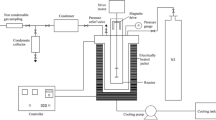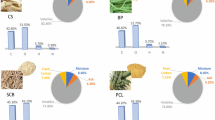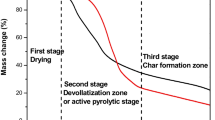Abstract
The coconut industry has great economic importance for the Asia–Pacific region and Brazil. For this reason, researchers have given special attention to coconut shells and fibers as fuel sources. However, other residues as coconut inflorescence wastes (CIW) have been neglected. In this work, CIW were pyrolyzed. Effects of pyrolysis temperature (290–710 °C) and heating rate (2–58 °C∙min−1) were evaluated. A full factorial design (FFD) was developed to identify interaction effects. Product (biochar, gas and bio-oil) yield and phenol concentration in the bio-oil (\(C_{{{\text{Phenol}}}}\)) were the responses investigated. Response surface methodology and central composite design (CCD) were used to obtain optimum conditions. Biomass and bio-oil were further characterized by thermogravimetric (TG) and GC–MS analyses. TG results indicated the FFD levels. Temperature and heating rate showed significant effects on the responses. A linear model was suitable for gas yield, while quadratic models were fitted to other responses. A trade-off analysis between bio-oil yield and \(C_{{{\text{Phenol}}}}\) detected optimum values of 42.9% and 47.1 mg g−1 at 530 ºC and 4.0 ºC min−1. Finally, phenolic compounds accounted for 77.8% of total peak area of the bio-oil based on GC–MS results. Therefore, bio-oil produced by pyrolysis of CIW showed to be a promising source of phenols for industrial use.
Graphical abstract

Article Highlights
-
Pyrolysis of coconut inflorescence wastes (CIW) was investigated.
-
Effects of pyrolysis temperature and heating rate were evaluated on the responses.
-
RSM and CCD were used to obtain maximum product yield and phenol concentration.
-
A trade-off analysis based on the desirability function suggested optimum values.
-
Coconut inflorescence biomass and bio-oil were characterized by TD/DTG and GC-MS.







Similar content being viewed by others
References
Al Arni S (2018) Comparison of slow and fast pyrolysis for converting biomass into fuel. Renew Energy 124:197–201. https://doi.org/10.1016/j.renene.2017.04.060
Ali I, Bahaitham H, Naebulharam R (2017) A comprehensive kinetics study of coconut shell waste pyrolysis. Bioresour Technol 235:1–11. https://doi.org/10.1016/j.biortech.2017.03.089
Almeida TM, Bispo MD, Cardoso ART, Migliorini MV, Schena T, Campos MCV, Machado ME, López JA, Krause LC, Caramão EB (2013) Preliminary studies of bio-oil from fast pyrolysis of coconut fibers. J Agric Food Chem 61:6812–6821. https://doi.org/10.1021/jf401379s
Alves JLF, Silva JCG, Mumbach GD, Sena RF, Machado RAF, Marangoni C (2022) Prospection of catole coconut (Syagrus cearensis) as a new bioenergy feedstock: insights from physicochemical characterization, pyrolysis kinetics, and thermodynamics parameters. Renew Energy 181:207–218. https://doi.org/10.1016/j.renene.2021.09.053
Araújo LKF, Albuquerque AA, Ramos WCO, Santos AT, Carvalho SHV, Soletti JI, Bispo MD (2021) Elaeis guineensis-activated carbon for methylene blue removal: adsorption capacity and optimization using CCD-RSM. Environ Dev Sustain 23:11732–11750. https://doi.org/10.1007/s10668-020-01137-7
Auad P, Spier F, Gutterres M (2020) Vegetable tannin composition and its association with the leather tanning effect. Chem Eng Commun 207:722–732. https://doi.org/10.1080/00986445.2019.1618843
Avelino F, Silva KT, Souza Filho MSM, Mazzetto SE, Lomonaco D (2018) Microwave-assisted organosolv extraction of coconut shell lignin by Brønsted and Lewis acids catalysts. J Clean Prod 189:785–796. https://doi.org/10.1016/j.jclepro.2018.04.126
Ayala-Cortés A, Lobato-Peralta DR, Arreola-Ramos CE, Martínez-Casillas DC, Pacheco-Catalán DE, Cuentas-Gallegos AK, Arancibia-Bulnes CA, Villafán-Vidales HI (2019) Exploring the influence of solar pyrolysis operation parameters on characteristics of carbon materials. J Anal Appl Pyrol 140:290–298. https://doi.org/10.1016/j.jaap.2019.04.006
Azeta O, Ayeni AO, Agboola O, Elehinafe FB (2021) A review on the sustainable energy generation from the pyrolysis of coconut biomass. Sci Afr 13:e00909. https://doi.org/10.1016/j.sciaf.2021.e00909
Aziz SMA, Shariff A, Abdullah N, Noor NM (2018) Characteristics of coconut frond as a potential feedstock for biochar via slow pyrolysis. Malays J Fundam Appl Sci 14:408–413. https://doi.org/10.1113/mjfas.v14n4.1014
Bai X, Kim KH (2016) In: Fang Z, Smith JRL (ed) Biofuels and chemicals from lignin based on pyrolysis. Springer Singapore, Singapore
Barros Neto B, Bruns RE, Scarminio IS (2010) How to do experiments: applications in science and industry. Bookman, Porto Alegre
Bhattacharjee N, Biswas AB (2018) Pyrolysis of Alternanthera philoxeroides (alligator weed): effect of pyrolysis parameter on product yield and characterization of liquid product and bio char. J Energy Inst 91:605–618. https://doi.org/10.1016/j.joei.2017.02.011
Cabral MMS, Abud AKS, Silva CEF, Almeida RMRG (2016) Bioethanol production from coconut husk fiber. Ciência Rural 46:1872–1877. https://doi.org/10.1590/0103-8478cr20151331
Carrier M, Hugo T, Gorgens J, Knoetze H (2011) Comparison of slow and vacuum pyrolysis of sugar cane bagasse. J Anal Appl Pyrol 90:18–26. https://doi.org/10.1016/j.jaap.2010.10.001
Chatterjee S, Kumar A, Basu S, Dutta S (2012) Application of response surface methodology for methylene blue dye removal from aqueous solution using low cost adsorbent. Chem Eng J 181–182:289–299. https://doi.org/10.1016/j.cej.2011.11.081
Chen D, Li Y, Cen K, Luo M, Li H, Lu B (2016) Pyrolysis polygeneration of poplar wood: effect of heating rate and pyrolysis temperature. Biores Technol 218:780–788. https://doi.org/10.1016/j.biortech.2016.07.049
Cheng S, Shu J, Xia H, Wang S, Zhang L, Peng J, Li C, Jiang X, Zhang Q (2019) Pyrolysis of crofton weed for the production of aldehyde rich bio-oil and combustible matter rich bio-gas. Appl Therm Eng 148:1164–1170. https://doi.org/10.1016/j.applthermaleng.2018.12.009
Choudhury ND, Bhuyan N, Bordoloi N, Saikia N, Kataki R (2020) Production of bio-oil from coir pith via pyrolysis: kinetics, thermodynamics, and optimization using response surface methodology. Biomass Convers Biorefin. https://doi.org/10.1007/s13399-020-00630-3
De Wild PJ, Huijgen WJ, Gosselink RJ (2014) Lignin pyrolysis for profitable lignocellulosic biorefineries. Biofuels, Bioprod Biorefin 8(5):645–657. https://doi.org/10.1002/bbb.1474
Derringer G, Suich R (1980) Simultaneous optimization of several response variables. J Qual Technol 12:214–219. https://doi.org/10.1080/00224065.1980.11980968
DPCleanTech (2017) Understanding coconut as a biomass fuel. www.dpcleantech.com. Accessed 12 Dec 2019
Dutta S, Bhattacharyya A, Ganguly A, Gupta S, Basu S (2011) Application of response surface methodology for preparation of low-cost adsorbent from citrus fruit peel and for removal of methylene blue. Desalination 275:26–36. https://doi.org/10.1016/j.desal.2011.02.057
Elkasabi Y, Mullen CA, Boateng AA (2020) Continuous extraction of phenol and cresols from advanced pyrolysis oils. SN Appl Sci 2:1–9. https://doi.org/10.1007/s42452-020-2134-4
Environmental Protection Agency (EPA) (2016) Phenol. https://www.epa.gov/sites/production/files/2016-09/documents/phenol.pdf. Accessed 10 Nov 2019
Fan Y, Liu C, Kong X, Han Y, Lei M, Xiao R (2021) A new perspective on polyethylene-promoted lignin pyrolysis with mass transfer and radical explanation. Green Energy Environ. https://doi.org/10.1016/j.gee.2021.02.004 (in Press)
Fardhyanti DS, Damayanti A (2017) Analysis of bio-oil produced by pyrolysis of coconut shell. Int J Chem Mol Eng 11:651–654
Fardyanti DS, Megawati, Istanto H, Anajib MK, Habibah PU (2018a) Extraction of phenol from bio-oil produced by pyrolysis of coconut shell. J Phys Sci 29:195–202. https://doi.org/10.2115/jps2018.29.s2.15
Fardhyanti D, Megawati KC, Lestari RAS, Triwibowo B (2018b) Producing bio-oil from coconut shell by fast pyrolysis processing. MATEC Web Conf 237:02001. https://doi.org/10.1051/matecconf/201823702001
Fisher T, Hajaligol M, Waymack B, Kellogg D (2002) Pyrolysis behavior and kinetics of biomass derived materials. J Anal Appl Pyrol 62:331–349. https://doi.org/10.1016/S0165-2370(01)00129-2
Food and Agriculture Organization of the United Nations (FAO) (2020) FAOSTAT. http://www.fao.org/home/en/. Accessed 08 Jan 2021
Gao Y, Yang Y, Qin Z, Sun Y (2016) Factors affecting the yield of bio-oil from the pyrolysis of coconut shell. Springerplus 5:1–8. https://doi.org/10.1186/s40064-016-1974-2
Garg R, Anand N, Kumar D (2016) Pyrolysis of babool seeds (Acacia nilotica) in a fixed bed reactor and bio-oil characterization. Renew Energy 96:167–171. https://doi.org/10.1016/j.renene.2016.04.059
Ghaedi M, Mazaheri H, Khodadoust S, Hajati S, Purkait MK (2015) Application of central composite design for simultaneous removal of methylene blue and Pb2+ ions by walnut wood activated carbon. Spectrochim Acta Part A Mol Biomol Spectrosc 135:479–490. https://doi.org/10.1016/j.saa.2014.06.138
Guedes RE, Luna AS, Torres AR (2018) Operating parameters for bio-oil production in biomass pyrolysis: a review. J Anal Appl Pyrol 129:134–149. https://doi.org/10.1016/j.jaap.2017.11.019
Guzelciftci B, Park KB, Kim JS (2020) Production of phenol-rich bio-oil via a two-stage pyrolysis of wood. Energy 200:117536. https://doi.org/10.1016/j.energy.2020.117536
HexaResearch (2017) Phenol market size and forecast analysis by end-use (bisphenol-a, phenolic resins, caprolactam), and trend analysis, 2014–2025. https://www.hexaresearch.com/research-report/phenol-market. Accessed 18 Dec 2019
Isahak WNRW, Hisham MWM, Yarmo MA, Hin TY (2012) A review on bio-oil production from biomass by using pyrolysis method. Renew Sustain Energy Rev 16:5910–5923. https://doi.org/10.1016/j.rser.2012.05.039
Kawale HD, Kishore N (2020) Pyrolysis of delonix regia and characterization of its pyrolytic products: effect of pyrolysis temperature. J Energy Res Technol 142:1–11. https://doi.org/10.1115/1.4046226
Kim JS (2015) Production, separation and applications of phenolic-rich bio-oil – a review. Bioresour Technol 178:90–98
Lédo AS, Passos EEM, Fontes HR, Ferreira JMS, Talamini V, Vendrame WA (2019) Advances in Coconut palm propagation. Fruit-Cult Braz J 41:1–14. https://doi.org/10.1590/0100-29452019159 (in Portuguese)
Li R, Zeng K, Soria J, Mazza G, Gauthier D, Rodriguez R, Flamant G (2016) Product distribution from solar pyrolysis of agricultural and forestry biomass residues. Renew Energy 89:27–35. https://doi.org/10.1016/j.renene.2015.11.071
Medeiros LCD, Pimenta AS, Braga RM, Carnaval TKA, Medeiros Neto PN, Melo DMA (2020) Effect of pyrolysis heating rate on the chemical composition of wood vinegar from Eucalyptus urograndis and Mimosa tenuiflora. Revista Árvore 43:1–11. https://doi.org/10.1590/1806-90882019000400008
Montgomery D, Peck E, Vining G (2012) Introduction to linear regression analysis. Wiley-Blackwell, Hoboken
Ngo T-A, Kim J, Kim S-S (2014) Characteristics of palm bark pyrolysis experiment oriented by central composite rotatable design. Energy 66:7–12. https://doi.org/10.1016/j.energy.2013.08.011
Paenpong C, Pattiya A (2016) Effect of pyrolysis and moving-bed granular filter temperatures on the yield and properties of bio-oil from fast pyrolysis of biomass. J Anal Appl Pyrol 119:40–51. https://doi.org/10.1016/j.jaap.2016.03.019
Panwar NL, Paul AS (2021) An overview of recent development in bio-oil upgrading and separation techniques. Environ Eng Res 26:200382. https://doi.org/10.4491/eer.2020.382
Panzella L, Napolitano A (2017) Natural phenol polymers: recent advances in food and health applications. Antioxidants (basel, Switzerland) 6:1–24. https://doi.org/10.3390/antiox6020030
Prins MJ, Ptasinski KJ, Janssen FJJG (2006) Torrefaction of wood: part 2. Analysis of products. J Anal Appl Pyrol 77:35–40. https://doi.org/10.1016/j.jaap.2006.01.001
Pütün AE, Apaydın E, Pütün E (2004) Rice straw as a bio-oil source via pyrolysis and steam pyrolysis. Energy 29:2171–2180. https://doi.org/10.1016/j.energy.2004.03.020
Reshad AS, Tiwari P, Goud VV (2019) Thermal and co-pyrolysis of rubber seed cake with waste polystyrene for bio-oil production. J Anal Appl Pyrol 139:333–343. https://doi.org/10.1016/j.jaap.2019.03.010
Ridout AJ, Carrier M, Collard F-X, Görgens J (2016) Energy conversion assessment of vacuum, slow and fast pyrolysis processes for low and high ash paper waste sludge. Energy Convers Manag 111:103–114. https://doi.org/10.1016/j.enconman.2015.12.043
Ruan R, Zhang Y, Chen P, Liu S, Fan L, Zhou N, Ding K, Peng P, Addy M, Cheng Y, Anderson E, Wang Y, Liu Y, Lei H, Li B (2019) In: Pandey A, Larroche C, Dussap C-G, Gnansounou E, Khanal SK, Ricke S (ed) Chapter 1—Biofuels: Introduction. Academic Press, London
Sanchez-Silva L, López-González D, Villaseñor J, Sánchez P, Valverde JL (2012) Thermogravimetric–mass spectrometric analysis of lignocellulosic and marine biomass pyrolysis. Bioresour Technol 109:163–172. https://doi.org/10.1016/j.biortech.2012.01.001
Sandes LVO, Vieira WT, Albuquerque AA, Bezerra PXO, Ribeiro LMO, Carvalho SHV, Soletti JI, Bispo MD (2021) Pyrolysis of lignocellulosic waste from second-generation ethanol industry. Sugar Tech 23:615–626. https://doi.org/10.1007/s12355-020-00941-9
Schena T, Farrapeira R, Bjerk TR, Krause LC, von Mühlen C, Caramão EB (2019) Fast two-dimensional gas chromatography applied in the characterization of bio-oil from the pyrolysis of coconut fibers. Sep Science plus 2:89–99. https://doi.org/10.1002/sscp.201800129
Shah Z, Veses RC, Ceschi MA, Silva R (2015) Separation of phenol from bio-oil produced from pyrolysis of agricultural wastes. Modern Chem Appl 5:1–8. https://doi.org/10.4172/2329-6798.1000199
Sharma R, Sheth P (2015) Thermo-chemical conversion of jatropha deoiled cake: pyrolysis vs. gasification. Int J Chem Eng Appl 6:376–380. https://doi.org/10.7763/IJCEA.2015.V6.513
Sobral KMB, Queiroz MA, Ledo CAS, Loiola CM, Andrade JB, Ramos SRR (2018) Genetic diversity assessment among tall coconut palm. Caatinga J 31:28–39. https://doi.org/10.1590/1983-21252018v31n104rc (in Portuguese)
Stefanidis SD, Kalogiannis KG, Iliopoulou EF, Michailof CM, Pilavachi PA, Lappas AA (2014) A study of lignocellulosic biomass pyrolysis via the pyrolysis of cellulose, hemicellulose and lignin. J Anal Appl Pyrol 105:143–150. https://doi.org/10.1016/j.jaap.2013.10.013
Toro-Trochez JL, Carrillo-Pedraza ES, Bustos-Martínez D, García-Mateos FJ, Ruiz-Rosas RR, Rodríguez-Mirasol J, Cordero T (2019) Thermogravimetric characterization and pyrolysis of soybean hulls. Bioresour Technol Rep 6:183–189. https://doi.org/10.1016/j.biteb.2019.02.009
Tsai WT, Lee MK, Chang YM (2006) Fast pyrolysis of rice straw, sugarcane bagasse and coconut shell in an induction-heating reactor. J Anal Appl Pyrol 76:230–237. https://doi.org/10.1016/j.jaap.2005.11.007
Tuncel F, Gercel HF (2004) Production and characterization of pyrolysis oils from euphorbia macroclada. Energy Sour 26:761–770. https://doi.org/10.1080/00908310490451394
Tungmunnithum D, Thongboonyou A, Pholboon A, Yangsabai A (2018) Flavonoids and other phenolic compounds from medicinal plants for pharmaceutical and medical aspects: an overview. Medicines 5:93. https://doi.org/10.3390/medicines5030093
Uçar S, Karagöz S (2009) The slow pyrolysis of pomegranate seeds: the effect of temperature on the product yields and bio-oil properties. J Anal Appl Pyrol 84:151–156. https://doi.org/10.1016/j.jaap.2009.01.005
van Den Dool H, Kratz PD (1963) A generalization of the retention index system including linear temperature programmed gas—liquid partition chromatography. J Chromatogr A 11:463–471. https://doi.org/10.1016/S0021-9673(01)80947-X
Varma AK, Mondal P (2017) Pyrolysis of sugarcane bagasse in semi batch reactor: effects of process parameters on product yields and characterization of products. Ind Crops Prod 95:704–717. https://doi.org/10.1016/j.indcrop.2016.11.039
von Mühlen C, Marriott PJ (2011) Retention indices in comprehensive two-dimensional gas chromatography. Anal Bioanal Chem 401:2351–2360. https://doi.org/10.1007/s00216-011-5247-1
Wang Q-d, Wang G-h, Li W-b, Chen B (2016) Production of hydrogen-rich syngas from lignite using different pyrolysis methods. Energy Technol 4:751–757. https://doi.org/10.1002/ente.201500479
Wang H, Wang X, Cui Y, Xue Z, Ba Y (2018) Slow pyrolysis polygeneration of bamboo (Phyllostachys pubescens): product yield prediction and biochar formation mechanism. Biores Technol 263:444–449. https://doi.org/10.1016/j.biortech.2018.05.040
Wannapeera J, Fungtammasan B, Worasuwannarak N (2011) Effects of temperature and holding time during torrefaction on the pyrolysis behaviors of woody biomass. J Anal Appl Pyrol 92:99–105. https://doi.org/10.1016/j.jaap.2011.04.010
Xu Y, Guo L, Zhang H, Zhai H, Ren H (2019) Research status, industrial application demand and prospects of phenolic resin. RSC Adv 9:28924–28935. https://doi.org/10.1039/C9RA06487G
Yu S, Park J, Kim M, Ryu C, Park J (2019) Characterization of biochar and byproducts from slow pyrolysis of hinoki cypress. Bioresour Technol Rep 6:217–222. https://doi.org/10.1016/j.biteb.2019.03.009
Zhao Z, Jiang Z, Xu H, Yan K (2021) Selective production of phenol-rich bio-oil from corn straw waste by direct microwave pyrolysis without extra catalyst. Front Chem 9:700887. https://doi.org/10.3389/fchem.2021.700887
Zhou X, Li W, Mabon R, Broadbelt LJ (2017) A critical review on hemicellulose pyrolysis. Energy Technol 5:52–79. https://doi.org/10.1002/ente.201600327
Acknowledgements
The authors acknowledge the financial support from the Brazilian Federal Agency for Support and Evaluation of Graduate Education – Capes; National Council for Scientific and Technological Development—CNPq; Research Support Foundation of the State of Alagoas—FAPEAL; National Agency for Petroleum, Natural Gas and Biofuels—ANP, of the Agency for the Financing of Studies and Projects—FINEP—and of the Ministry of Science, Technology and Innovation—MCTI through the Training Program of Human Resources of the ANP for the Oil, Gas and Biofuel Sectors—PRH-ANP/MCTI.
Author information
Authors and Affiliations
Corresponding author
Ethics declarations
Conflict of Interest
On behalf of all authors, the corresponding author states that there is no conflict of interest.
Rights and permissions
About this article
Cite this article
Farias, R.O., Lins, P.V.S., Gabriel, R. et al. Pyrolysis of Coconut Inflorescence Wastes: Production, Effects of Parameters, Characterization and Optimization of Phenolic-Rich Bio-Oil. Int J Environ Res 16, 15 (2022). https://doi.org/10.1007/s41742-022-00393-x
Received:
Revised:
Accepted:
Published:
DOI: https://doi.org/10.1007/s41742-022-00393-x




